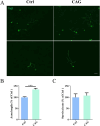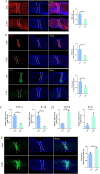Cycloastragenol promotes dorsal column axon regeneration in mice
- PMID: 39830038
- PMCID: PMC11739090
- DOI: 10.3389/fncel.2024.1424137
Cycloastragenol promotes dorsal column axon regeneration in mice
Abstract
Introduction: Cycloastragenol (CAG) has a wide range of pharmacological effects, including anti-inflammatory, antiaging, antioxidative, and antitumorigenic properties. In addition, our previous study showed that CAG administration can promote axonal regeneration in peripheral neurons. However, whether CAG can activate axon regeneration central nervous system (CNS) remains unknown.
Methods: Here, we established a novel mouse model for visualizing spinal cord dorsal column axon regeneration involving the injection of AAV2/9-Cre into the lumbar 4/5 dorsal root ganglion (DRG) of Rosa-tdTomato reporter mice. We then treated mice by intraperitoneal administration of CAG.
Results: Our results showed that intraperitoneal CAG injections significantly promoted the growth of vitro-cultured DRG axons as well as the growth of dorsal column axons over the injury site in spinal cord injury (SCI) mice. Our results further indicate that CAG administration can promote the recovery of sensory and urinary function in SCI mice.
Conclusion: Together, our findings highlight the therapeutic potential of CAG in spinal cord injury repair.
Keywords: TERT; axon growth; cycloastragenol; dorsal column; functional recovery; nerve injury; p53; spinal cord injury.
Copyright © 2025 Zihan, Wenwen, Yanxia and Saijilafu.
Conflict of interest statement
The authors declare that the research was conducted in the absence of any commercial or financial relationships that could be construed as a potential conflict of interest.
Figures






Similar articles
-
miR-155 Deletion in Mice Overcomes Neuron-Intrinsic and Neuron-Extrinsic Barriers to Spinal Cord Repair.J Neurosci. 2016 Aug 10;36(32):8516-32. doi: 10.1523/JNEUROSCI.0735-16.2016. J Neurosci. 2016. PMID: 27511021 Free PMC article.
-
Genetic study of axon regeneration with cultured adult dorsal root ganglion neurons.J Vis Exp. 2012 Aug 17;(66):4141. doi: 10.3791/4141. J Vis Exp. 2012. PMID: 23117482 Free PMC article.
-
Profiling sensory neuron microenvironment after peripheral and central axon injury reveals key pathways for neural repair.Elife. 2021 Sep 29;10:e68457. doi: 10.7554/eLife.68457. Elife. 2021. PMID: 34586065 Free PMC article.
-
Intrinsic regulation of axon regeneration after spinal cord injury: Recent advances and remaining challenges.Exp Neurol. 2022 Nov;357:114198. doi: 10.1016/j.expneurol.2022.114198. Epub 2022 Aug 6. Exp Neurol. 2022. PMID: 35944658 Review.
-
Netrin-1 signaling for sensory axons: Involvement in sensory axonal development and regeneration.Cell Adh Migr. 2009 Apr-Jun;3(2):171-3. doi: 10.4161/cam.3.2.7837. Epub 2009 Apr 14. Cell Adh Migr. 2009. PMID: 19262170 Free PMC article. Review.
References
LinkOut - more resources
Full Text Sources
Research Materials
Miscellaneous

